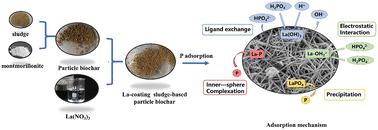Sludge-based biochar with lanthanum modification for phosphate recovery from wastewater streams†
Abstract
Sludge-based biochar for phosphate recovery has been considered a promising and sustainable option for sludge utilization as well as eutrophication control. However, it is still a challenge that their phosphate recovery performances are unsatisfactory for real wastewater, especially for anaerobic digestion liquid with high phosphate and complex composition. In this study, municipal sludge-based biochar granular particles (SBP) were prepared and modified with lanthanum (La) for phosphate recovery from wastewater streams. The resulting SBP and La modified SBP (SBP–La) presented low ecological risk and high safety according to the negligible heavy metal leaching. For both anaerobic digestion liquid and wastewater, SBP–La can effectively remove >99.9% phosphate with relatively lower adsorbent loading (0.1–0.5 times dosage of SBP). Results of systematic batch experiments suggested that SBP–La exhibited fast kinetics of <24 hours and a high phosphate recovery capacity of 46.5 mg g−1 under wastewater-relevant solution conditions. SBP–La can also be conveniently regenerated by NaOH solution and reused for complete phosphate removal for at least five cycles. Furthermore, electrostatic interaction, precipitation and inner-sphere complexation via ligand exchange were proposed to achieve high phosphate recovery by SBP–La. This study presented SBP–La as a sustainable option for sludge reuse as a promising phosphate recovery adsorbent for wastewater streams, especially for anaerobic digestion liquid.

- This article is part of the themed collection: Environmental Science: Water Research & Technology Recent HOT Articles


 Please wait while we load your content...
Please wait while we load your content...